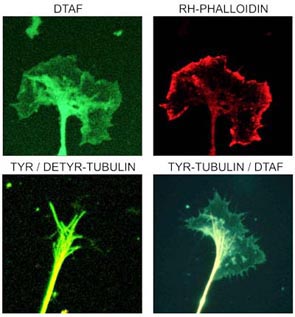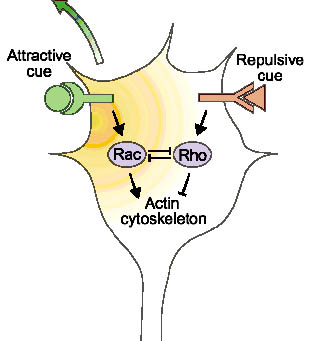Institute of Neurobiochemistry
Molecular basis of axonal growth and regeneration
Head: Christine Bandtlow, PhD
secretariat:
Tel.:+43-512-9003-70281
Fax.: +43-512-9003-73280
Main Goals, Keywords
Characterization of myelin-associated neurite growth inhibitors and their cognate receptors in the central nervous system. Signal transduction of neurite growth inhibitors in the brain with special emphasis on effects on cytoskeletal changes in neuronal growth cones.
Previous and Current Research
Injuries to the axons of neurons in the CNS (brain and spinal cord) of higher vertebrates normally lead to irreversible damage since neither neurons nor their axons can regenerate. One of the major impediments to regeneration are growth repulsive and inhibitory molecules present in myelin. Recent efforts by many laboratories have lead to the identification of Nogo, myelin-associated glycoprotein (MAG) and chondroitin-sulfate proteoglycans as the main inhibitors of neurite growth. They are known to act on the sensory apparatus of growing axons, the growth cone. The growth cone at the tip of extending axons can therefore be considered as a specialized structure that recognizes and distinguishes the presence of extracellular signals and transduces this informations into directed axonal growth. A three-dimensional filamentous meshwork, the cytoskeleton, appears to be the molecular base for growth cone movements. In particular, changes in the internal organisation of actin filaments and microtubuli determines not only the shape of growth cone structures but also their motility and growth direction. Our main research interests are the cellular and molecular mechanisms by which repulsive molecules are transduced to cytoskeletal re-arrangements.

Growth cones of embryonic day 15 chick dorsal root ganglion
neurons stained with various antibodies against total proteins (DTAF),
F-actin (Rh-Phalloidin),
tyrosinylated alpha-tubulin (Tyr-tubulin, green) and de-tyrosinylated
alpha-tubulin (Detyr-tubulin, yellow).

Possible crosstalk of attractive and repulsive axonal guidance molecules in
regulating growth cone behaviour
Future Projects
We will continue our efforts to identify the neuronal receptors and binding molecules of myelin associated neurite growth inhibitors, their signal transduction mechanisms, with special emphasis on the possible involvement of small GTP-binding molecules of the rho-family, calcium transients and down-stream effectors.
Techniques and Equipment
Modern biochemical and molecular biological techniques, cell culture work on primary neuronal and glial cells including video-time-lapse microscopy, calcium imaging, and confocal immunocytochemistry.
Selected Lectures, Seminars or Colloquia
1. Biochemistry and Chemistry
2. Neurobiology Seminar
Funding
Swiss National Science Foundation
Österreichische Nationalbank
Positions
Positions for Diploma and PhD thesis projects
Visit the new lectures webpage / Besuchen Sie die neue Vorlesungsseite



